Our Services
Biotechnology products and tools for researches and applications in medical sciences, food safety, environment protection and life sciences.
The query in PubMed using Biacore as keyword results in a of 1515 related articles dated from year 1992 to now (by the date of 31 August 2020).
Publications with applications of Biacore systems and Surface Plasmon Resonance (SPR) technology between 2001 and 2012 showed increasing very fast.
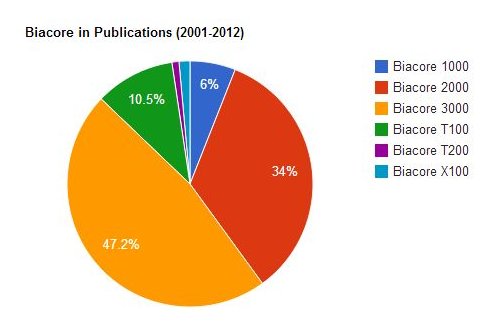
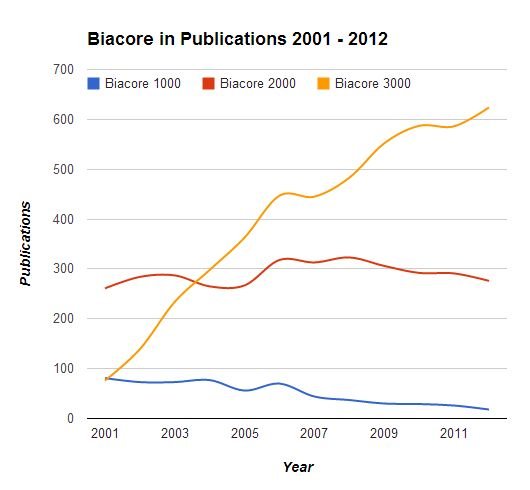
About 20 year in the research laboratory, the Biacore systems were evolved many new generations through technology advance. By searching Google Scholar, the publications that used one of the Biacore systems revealed the up and down of each Biacore system. The most robust system is Biacore 3000 which is still one of the most popular systems used in publications in all time. The newly generation of Biacore system, the T200 is catching up very quickly in recent years and over taking Biacore 3000 since 2016 and becoming the new most popular system in publications.
Measuring Protein-Protein Interactions Using Biacore. Leonard P, Hearty S, Ma H, O'Kennedy R. Methods Mol Biol. 2017;1485:339-354. PMID: 27730561
Evaluation of calibration-free concentration analysis provided by Biacore™ systems. Pol E, Roos H, Markey F, Elwinger F, Shaw A, Karlsson R. Anal Biochem. 2016 Oct 1;510:88-97. doi: 10.1016/j.ab.2016.07.009. Epub 2016 Jul 9. PMID: 27402174
Using Biacore to measure the binding kinetics of an antibody-antigen interaction. Murphy M, Jason-Moller L, Bruno J. Curr Protoc Protein Sci. 2006 Sep;Chapter 19:Unit 19.14. doi: 10.1002/0471142301.ps1914s45. PMID: 18429303
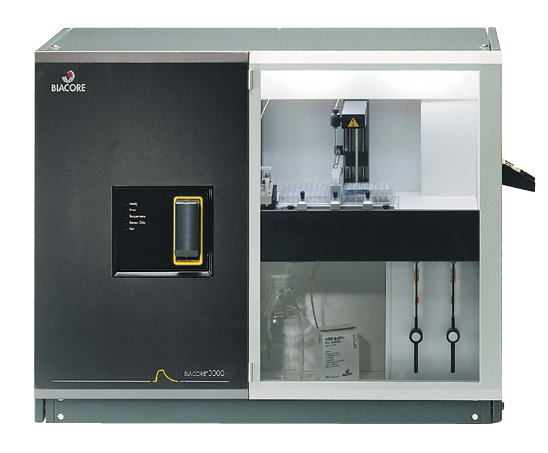 Australia Biacore resources include with details information of Biacore location, model, contact point and operation credibility. A resources for all you need to know about Biacore and surface plasmon resonance (SPR) technology with operation protocol, techniques and forum. Add your Biacore to the list below now and it is free.
Australia Biacore resources include with details information of Biacore location, model, contact point and operation credibility. A resources for all you need to know about Biacore and surface plasmon resonance (SPR) technology with operation protocol, techniques and forum. Add your Biacore to the list below now and it is free.
You are invited to join the Biacore Group on Linkedin ![]()
and share with

Our high quality and experienced bioanalytical services using the powerful technique of Surface Plasmon Resonance (SPR, Biacore) provides label-free, real time analysis of a pair of interacting molecules such as small molecule drugs binding to their target proteins. In more than 15 years Biobest acquired expert knowledge in application of Biacore SPR technology and has proven to be a reliable contractor for clients from pharmaceutical, research institutions and bio-diagnostic industry in supporting their specific projects. We especially have the experiences with a number of different SPR systems, such as Biacore 2000, Biacore 3000, Biacore X100. We can ensure a rapid and professional to assist to your samples analysis with tailor designed protocols as your specific requirements.
Biacore and SPR technology in Applications
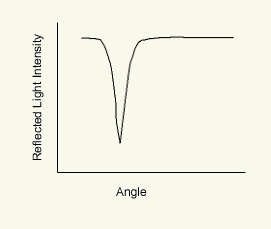 Surface Plasmon Resonance (SPR) is an optical detection process that occurs when a polarized light hits a prism covered by a thin (gold) metal layer. Under certain conditions (wavelength, polarization and incidence angle) free electrons at the surface of the bio-sensor chip absorb incident light photons and convert them into surface plasmon waves. A dip in reflectivity of the light is seen under these SPR conditions.
Surface Plasmon Resonance (SPR) is an optical detection process that occurs when a polarized light hits a prism covered by a thin (gold) metal layer. Under certain conditions (wavelength, polarization and incidence angle) free electrons at the surface of the bio-sensor chip absorb incident light photons and convert them into surface plasmon waves. A dip in reflectivity of the light is seen under these SPR conditions.
Perturbations at the gold surface of the bio-sensor chip, such as an interaction between probe molecules immobilized on the chip and captured target molecules, induce a modification of resonance conditions which are in turn seen as a change in reflectivity and which can be measured. This is the basis application of the SPR measurements, such as using a Biacore system.
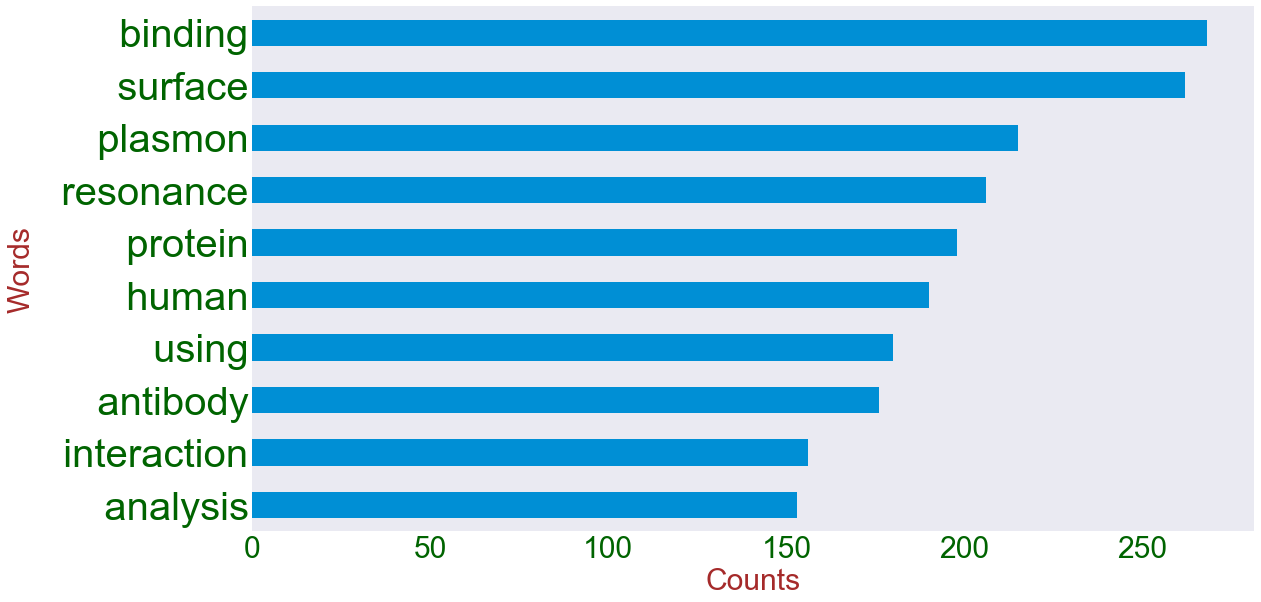
The query in PubMed using Biacore as a keyword results in a total of 1515 related articles dated between 1992 and 2020 (by the date of 31 August 2020).
All titles of 1515 articles were combined together to become a corpus of about 24000 words that subsequently analyzed using Python and its related programs. As the result, we can see there are about 4764 unique words from all those titles and the average words used in a title is about 16.
Furthermore, If we can find out what are the most popular words or most used words in those titles, we will get some clues about what Biacore really has been working on in the last 30 years. Luckly, with the help of fast development of big data technology, we can easily get this done using a set of programs that include Python, Pandas, Numpy, and so on. The result of top 10 most popular words from this 1515 PubMed publication titles show as above.
The most popular word is 'binding' that showed 268 times in 1515 titles, representing about 17.69% of total titles. This also means that nearly one fifth of published papers were simply investigating the binding properties.
Top 100 Words in Titles of Biacore Related Publications in PubMed
Biacore - A Keyword Search Query Results in PubMed
Top 50 Words From Titles of Biacore Related Publications in PubMed
The query in PubMed using Biacore as a keyword results in a total of 1515 related articles dated between 1992 and 2020 (by the date of 31 August 2020).
All titles of 1515 articles were combined together to become a corpus of about 24000 words that subsequently analyzed using Python and its related programs. A word cloud was generated as shown below that showed a visual impact of key words in relationship with Biacore technology in the real world.
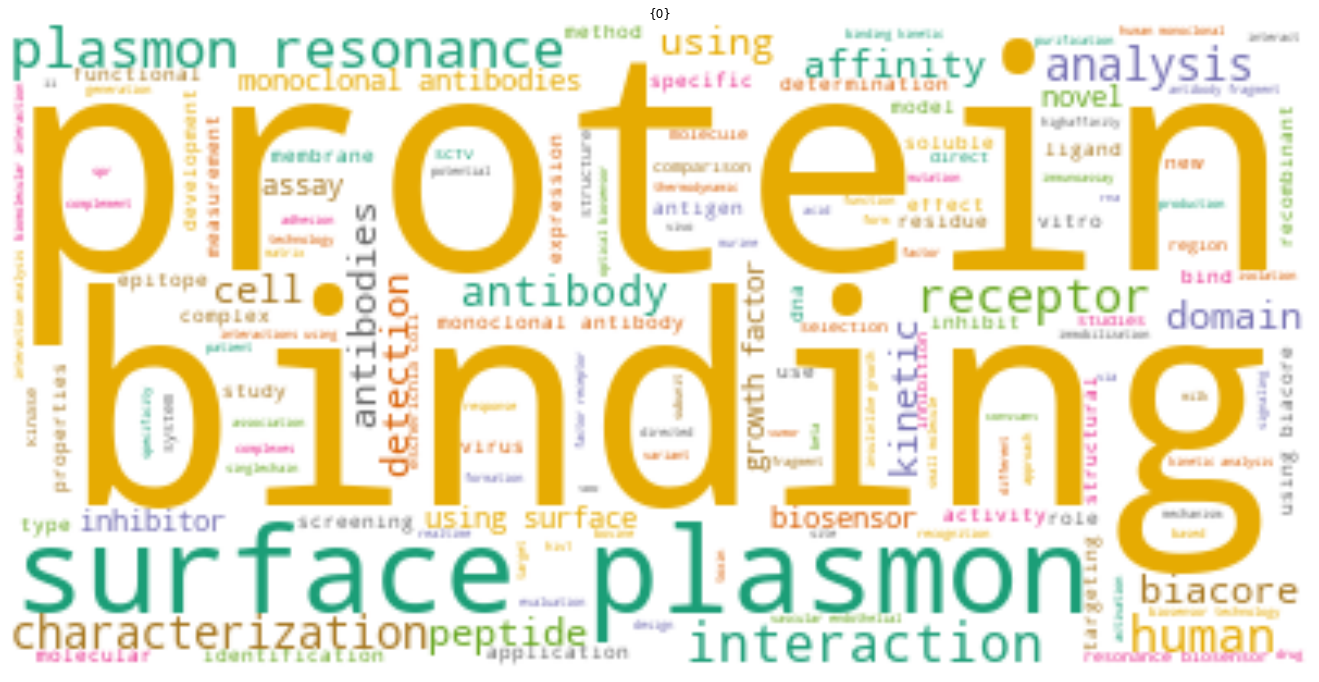
The top 100 words are listed in the table below. Words appeared how many times in titles was summed as counts. The most popular word (rank number 1) is binding that showed 268 counts in 1515 titles, representing about 17.69% of total titles. This also indicates that nearly one fifth of published papers were simply investigating the binding properties. The word 'Biacore' itself only ranked 17th the most popular word with 111 counts shown in titles.
| Rank | Word | Count | |
| 1 | binding | 268 | |
| 2 | surface | 262 | |
| 3 | plasmon | 215 | |
| 4 | resonance | 206 | |
| 5 | protein | 198 | |
| 6 | human | 190 | |
| 7 | using | 180 | |
| 8 | antibody | 176 | |
| 9 | interaction | 156 | |
| 10 | analysis | 153 | |
| 11 | receptor | 152 | |
| 12 | biosensor | 138 | |
| 13 | antibodies | 137 | |
| 14 | characterization | 130 | |
| 15 | monoclonal | 120 | |
| 16 | interactions | 116 | |
| 17 | biacore | 111 | |
| 18 | affinity | 100 | |
| 19 | factor | 97 | |
| 20 | growth | 81 | |
| 21 | proteins | 76 | |
| 22 | domain | 75 | |
| 23 | kinetic | 74 | |
| 24 | detection | 60 | |
| 25 | cell | 59 | |
| 26 | peptide | 59 | |
| 27 | virus | 58 | |
| 28 | novel | 55 | |
| 29 | activity | 54 | |
| 30 | functional | 53 | |
| 31 | cells | 52 | |
| 32 | identification | 46 | |
| 33 | recombinant | 44 | |
| 34 | kinetics | 42 | |
| 35 | specific | 42 | |
| 36 | technology | 42 | |
| 37 | antigen | 41 | |
| 38 | ligand | 41 | |
| 39 | molecular | 41 | |
| 40 | complex | 38 | |
| 41 | development | 38 | |
| 42 | assay | 37 | |
| 43 | dna | 37 | |
| 44 | vitro | 36 | |
| 45 | kinase | 35 | |
| 46 | acid | 35 | |
| 47 | singlechain | 35 | |
| 48 | new | 34 | |
| 49 | determination | 33 | |
| 50 | optical | 33 | |
| 51 | fragment | 33 | |
| 52 | expression | 32 | |
| 53 | screening | 32 | |
| 54 | role | 32 | |
| 55 | properties | 32 | |
| 56 | type | 32 | |
| 57 | targeting | 31 | |
| 58 | epitope | 31 | |
| 59 | inhibitor | 31 | |
| 60 | use | 30 | |
| 61 | spr | 30 | |
| 62 | coli | 30 | |
| 63 | inhibits | 29 | |
| 64 | peptides | 28 | |
| 65 | studies | 28 | |
| 66 | study | 28 | |
| 67 | effects | 27 | |
| 68 | rna | 27 | |
| 69 | receptors | 27 | |
| 70 | method | 26 | |
| 71 | fragments | 26 | |
| 72 | binds | 25 | |
| 73 | small | 25 | |
| 74 | soluble | 25 | |
| 75 | serum | 25 | |
| 76 | endothelial | 25 | |
| 77 | cancer | 25 | |
| 78 | structural | 25 | |
| 79 | constants | 25 | |
| 80 | phage | 24 | |
| 81 | direct | 24 | |
| 82 | purification | 23 | |
| 83 | tumor | 23 | |
| 84 | escherichia | 23 | |
| 85 | mapping | 23 | |
| 86 | application | 23 | |
| 87 | molecules | 22 | |
| 88 | comparison | 22 | |
| 89 | selection | 22 | |
| 90 | inhibition | 22 | |
| 91 | fab | 22 | |
| 92 | residues | 21 | |
| 93 | vascular | 21 | |
| 94 | immunoassay | 21 | |
| 95 | biosensors | 21 | |
| 96 | production | 21 | |
| 97 | inhibitors | 21 | |
| 98 | evaluation | 20 | |
| 99 | high | 20 | |
| 100 | scfv | 20 |
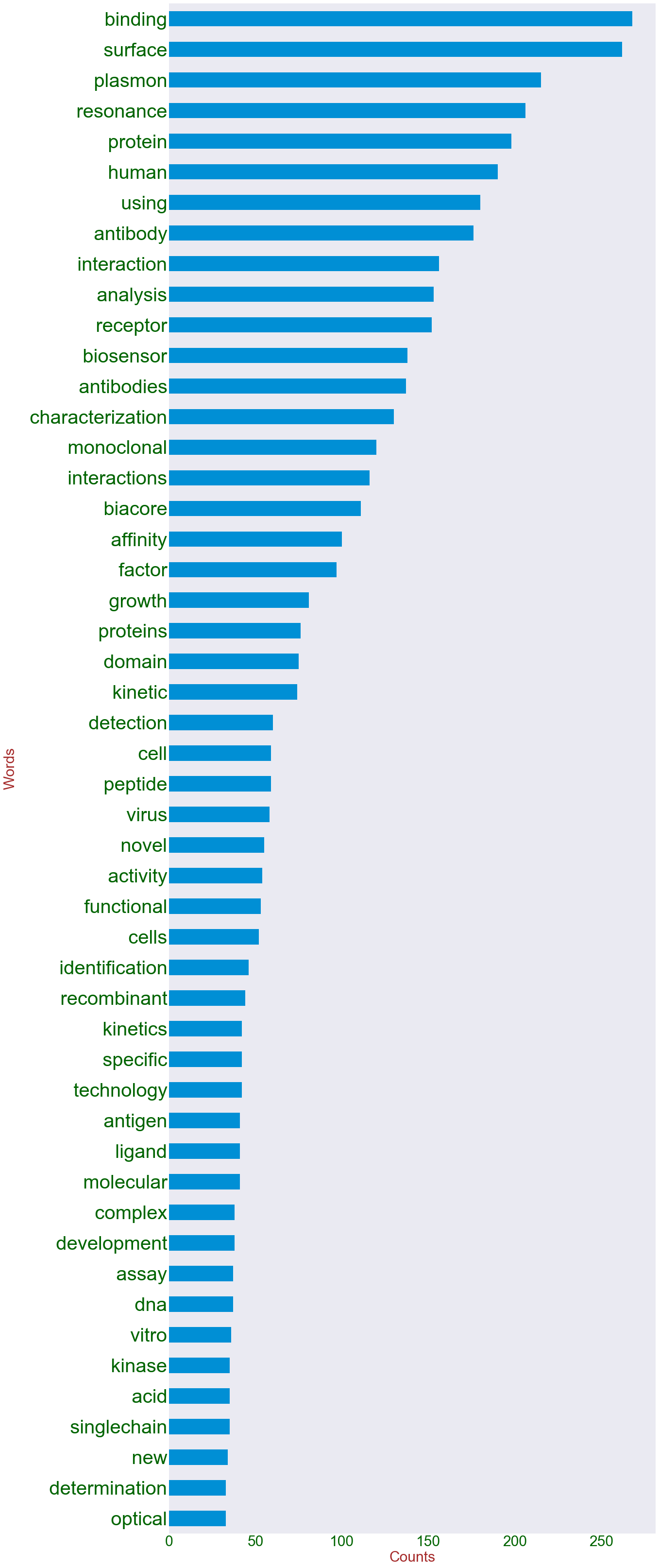
The query in PubMed using Biacore as a keyword results in a total of 1515 related articles dated between 1992 and 2020 (by the date of 31 August 2020).
All titles of 1515 articles were combined together to become a corpus of about 24000 words that subsequently analyzed using Python and its related programs. As the result, we can see there are about 4764 unique words from all those titles and the average words used in a title is about 16.
Furthermore, If we can find out what are the most popular words or most used words in those titles, we will get some clues about what Biacore really has been working on in the last 30 years. Luckly, with the help of fast development of big data technology, we can easily get this done using a set of programs that include Python, Pandas, Numpy, and so on. The result of top 50 most popular words from this 1515 PubMed publication titles show as above.
The most popular word is 'binding' that showed 268 times in 1515 titles, representing about 17.69% of total titles. This also means that nearly one fifth of published papers were simply investigating the binding properties. The word 'Biacore' itself only ranked 17th the most popular word with 111 times shown in titles.
Top 10 Words From Titles of Biacore Related Publications in PubMed
Top 100 Words in Titles of Biacore Related Publications in PubMed
